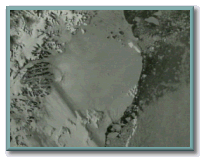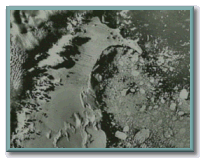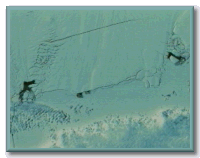They call this continent "The Ice": with good reason. 90% of all the ice on earth, and 70% of the fresh water on our planet, is found here.
Out at the American and Russian camps called "East" or "Vostok" you stand on nearly 2 miles of ice.
Flying over the West Antarctic ice sheet, the sea of frozen water seems to go on for ever.
Was it always this way? What if some, or all of this ice should melt?
This is how NASA researchers think Antarctica looked during the last ice age, some 20,000 years ago. You can see how much more ice there was. |
Image courtesy of NASA |
Since then, the West Antarctic ice sheet has lost nearly two thirds of its mass, enough to have raised global sea levels by some 33 feet.
Spacecraft like the U.S. / Canadian "Radarsat" and "Landsat 7" allow researchers to monitor changes in the ice. Some have been sudden, and dramatic.
We're looking at the Larsen B ice shelf, off the Antarctic Peninsula, where average summertime temperatures have risen nearly 5 degrees in 50 years!
Image courtesy of NASA
This is "before"...
and this is "after."
Image courtesy of NASA
Liquid water pools on the surface, and then forms wedges when it re-freezes.
Between 1995 and 1998 an area the size of Rhode Island broke off.
An "ice shelf" is the over-water extension of an "ice sheet," which sits on land. An ice shelf is already floating so this kind of disintegration is dramatic but has no effect on sea-level. But if this melting happened on the other side of the continent, and the Ross Ice Shelf collapsed in a major way, vast glaciers might flow down from the interior. Then sea levels might change dramatically. Has that started to happen?


Websites
• Larsen Ice Shelf Animation
Time series of Larsen ice shelf--December 26, 1993, February 13, 1995, March 21, 1998, November 21, 1998, and March 2, 2000.
![]()
